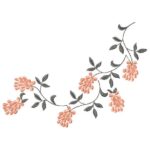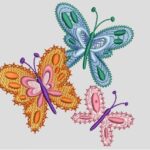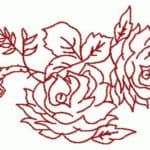What is embroidery stabilizer and How to choose it?
A stabilizer (alluded to in modern circles as support) is a fundamental for machine weaving. It is utilized to help the texture during the sewing system to continue to pucker or then again extending from happening.
The decision of stabilizer can represent the deciding moment a weaving project. Utilizing a stabilizer that is deficient for the texture or on the other hand the join count of the plan can make even awesome
digitized plan look awful.
Stabilizers are characterized by the strategy used to eliminate the overabundance from the rear of the venture after the plan has been sewed. The three most normal sorts are:
1) Cut-Away
2) Tear-Away
3) Wash-Away
Inside each gathering are a few loads of stabilizer.
• Pick the weight that most intently relates to the heaviness of the texture to be weaved.
• Pick the load as indicated by the fasten count of the plan – the more noteworthy the line count, the
heavier the stabilizer ought to be.
Sticking any of these stabilizers to the texture with a brief cement shower prior to hooping is
prescribed to hold the layers back from moving during the weaving process and to make the thing simpler to circle.
The most important factors to consider when choosing an appropriate stabilizer are:
1) Fabric
2) Embroidery Design
3) Back Appearance
4) The “Hand” or Feel
5) Test Results
Texture
• The main rule – – Use a remove stabilizer while weaving on sews or stretchy textures.
The remove will uphold the fastens not just during the weaving system itself, however during the
lifetime of the article of clothing too.
• Texture weight and stabilizer weight ought to be viable. As a general rule, the heavier the texture, the
heavier the stabilizer ought to be. On the other hand, the lighter, milder, or more drapey the texture, the lighter
the heaviness of the stabilizer ought to be.
• A sheer texture will require a water-dissolvable stabilizer so that no excess pieces of stabilizer will be seen
from the right side.
• The texture and picked plan ought to be viable. A lightweight texture can become overpowered by
a line concentrated plan. On the other hand, an open vaporous configuration can get outwardly derailed in a rested or weighty texture.
Weaving Design
• The more join in a plan, the heavier the It would be ideal for stabilizer to be.
• Utilize a very much digitized plan that has adequate underlay to offer base help for the join.
• Assuming it is important that you utilize a specific sort of stabilizer, pick the plan likewise.
Back Appearance
• In the event that you believe positively no stabilizer should show from some unacceptable side, you should utilize a water-solvent stabilizer.
• In the event that you are OK with the vast majority of the stabilizer being taken out, you can utilize a tear away.
• While utilizing a remove stabilizer, the overabundance must be removed leaving a circle of stabilizer on the back side of the venture.
The “Hand” or Feel
• The weight and kind of the stabilizer will impact the wrap of the texture.
− A significant burden stabilizer will add weight to the article of clothing. Indeed, even a weighty tear away stabilizer will add weight since some stabilizer will remain behind the join.
− The lighter the heaviness of the stabilizer, the more noteworthy the wrap of the texture will be.
− A wash away stabilizer will add no weight by any means to the texture after it is washed.
• The cut edges of a remove stabilizer stay on the posterior of the venture. The heavier the remove,
the seriously disturbing this edge could be on a piece of clothing that will be worn straightforwardly against the skin.
Test Results
Testing is in every case enthusiastically suggested. Despite the fact that you keep all the stabilizer rules, they are
simply that – rules. There are numerous factors in texture quality inside every texture gathering, as well as
contrasts in the nature of the plan. The most effective way to decide the legitimate stabilizer is to test.
Tear-Away Stabilizers
Remove stabilizers are viewed as the most steady of the three stabilizer types. They can be utilized on any texture type, yet all the same MUST be utilized while sewing on weaves or stretchy textures. The abundance
stabilizer will be removed, yet the stabilizer behind the fastens will show up for the lifetime of the piece of clothing and will keep the plan’s fastens from popping as the article of clothing is extended or controlled.
Evacuation:
• Trim with scissors no nearer than ј” to Ѕ” away from the edge of the plan and round any corners.
• Try not to endeavor to remove open regions inside the plan itself.
• Place the task with the stabilizer side down.
Accumulate the texture in your grasp and cut the stabilizer. This will keep you from unintentionally
cutting the texture!
Heavy Weight Tear-Away
• Tears away very cleanly and easily – stiff edges are easy to grasp
• Supports large number of stitches
• Great for items that need more support for heavier
stitch count designs
Medium Weight Tear-Away
• Available only in black
• Firm tear away, but very easy to remove
Ultra Clean and Tear
• A soft medium weight tear away stabilizer
• Removes very easily – does not stress the stitches as it is removed
• Remaining bers will easily wash away as the project is laundered
Light Weight Tear-Away
• The lightest weight of the tear away stabilizers – adds very little weight to the project
• Easy to tear away leaving a very clean edge
• Can be printed on and used for paper piecing
• Great for use when stitching decorative stitches on the sewing side
• Available in a fusible version (See Specialty Stabilizer section)
Wash-Away Stabilizers
Wash away stabilizers ought to be utilized when all follows of the stabilizer should be eliminated from the back
of the venture, for example, while utilizing a sheer texture or weaving a task that will be seen from the back
side as well as the front. Since this kind of stabilizer does not help however many fastens as tear away or remove stabilizers, cautious thought ought to be given to the plan decision. Try not to utilize this stabilizer if your texture can’t be washed.
Removal:
• Remove as much stabilizer as possible by tearing or cutting away the excess.
• Rinse the project under warm running water until all traces of the stabilizer are removed.
• When creating lace, the more it is washed, the softer the lace will be.
AquaFilm Backing
• A clear lightweight backing – quick to rinse away
• Use for quilting in the hoop if the quilt itself cannot be hooped
• Too lightweight for stand-alone lace
BadgeMaster
• A heavy clear backing
• Can be used for stand-alone lace
• Majority of stabilizer can be torn away before rinsing
AquaMesh
• An opaque backing that supports the greatest number of stitches
• Can be used in the creation of stand-alone lace
• Very stable water soluble stabilizer that is not prone to premature perforation during stitching
• Excess cannot be torn away – cut the excess away from the outer edges and then rinse
What is embroidery stabilizer and How to choose it?
Specialty Stabilizers
Fusible Stabilizers
Fusible stabilizers are utilized by cutting a loop measured piece of stabilizer and sticking it to the rear of the
texture. This will forestall extending of the texture during the hooping system, and will assist with keeping frames accurately enrolled. The texture/stabilizer is then hooped in the customary way.
FUSIBLE POLYMESH CUT AWAY
FUSIBLE TEAR AWAY
To use:
• Lightly adhere the adhesive side of the stabilizer to the back of the project in the area to be embroidered.
• After the embroidery has 뀠nished, carefully separate the stabilizer from the fabric (heating with an iron
very briefly may aid in this).
• Remove the excess by either cutting away the Fusible PolyMesh, or tearing away the Fusible Tear
Away.
Paper-Backed Pressure Sensitive Adhesive Stabilizers (aka sticky-backed stabilizers)
These stabilizers are used in the same manner. They are all coated with the same type of pressure-sensitive
adhesive with a protective paper backing. The difference will be in the number of stitches that
the stabilizer will support as well as the manner in which the excess stabilizer is removed. Select the
stabilizer type (cut away, tear away, or water-soluble) by applying the same principles as if using a regular
stabilizer. (Refer to earlier page on stabilizers.) Most generally these stabilizers are used for “hoopless” embroidery.
STABIL-STICK CUT AWAY
STABIL-STICK TEAR AWAY
AQUAMESH PLUS (WATER-SOLUBLE)
To use:
• Hoop with the paper side up.
• Score and remove the paper to reveal the sticky surface.
• Position the fabric over the sticky surface and smooth into place.
To remove:
• Separate the stabilizer from the fabric by gently pulling the layers apart.
• Remove the excess by either cutting, tearing, or washing it away depending on the type of stabilizer
used.
Water Activated Stabilizer
HYDRO-STICK TEAR AWAY
Hydro-Stick is a heavy weight tear away stabilizer with an adhesive coating that is activated by water. It is
most often used for “hoopless” embroidery. HydroStick holds the fabric VERY 뀠rmly. The project
cannot be accidentally bumped or moved out of place during the embroidery process.
It will not gum the needles since it is not a sticky adhesive.
To use:
• Hoop the stabilizer with the coated side up.
• Moisten the top slightly with water and adhere the fabric to the top of the hooped stabilizer.
• Allow the stabilizer to dry for a few minutes before embroidering.
To remove:
• Lift a loose corner of the stabilizer and apply moisture to the area between the stabilizer and the back
of the fabric.
• Continue to lift and moisten until the stabilizer has been separated. Then tear the excess away.
Toppings
As the name implies, toppings are used only on the top of the fabric to control the nap of the fabric. They are too lightweight to be used as the backing stabilizer.
AquaFilm Topping
• A clear water soluble product – excess easily removed with water
• Must be used on napped fabrics such as towels, knits, velvets, or velveteens to prevent the nap of
the fabric from poking through the stitches
• Improves the appearance of the embroidery design on any fabric with any kind of an irregular weave
To use:
• Place the AquaFilm over the top of the hooped fabric. AquaFilm does not need to be hooped with
the fabric, but it does need to be secured. − Moisten the corners and attach to the fabric, use
Painter’s Tape, or pins (carefully placed outside the stitching area) to hold the AquaFilm in place.
− Use a design basting box, or a hoop basting box to further secure the AquaFilm. Slow the machine
down to its slowest speed as the basting box is stitched. Using the foot control on your machine
will also give you greater control.
To remove:
• Carefully tear away as much of the AquaFilm as possible.
• The remainder can be rinsed away with water.
TopCover
TopCover is a vinyl type product that prevents the color of the fabric from showing through the stitches
as well as controlling the nap.
It is Ideal for use when stitching light designs on dark fabric, or vice versa. The TopCover behind the stitches
will remain there throughout the lifetime of the project.
To use:
• Place TopCover over the top of the hooped fabric. It does not need to be hooped with the fabric, but it
does need to be secured.
− Use Painter’s Tape or pins (carefully placed outside the stitching area) to hold it securely.
− Use a design basting box, or a hoop basting box to further secure the TopCover. Slow the machine
down to its slowest speed as the basting box is stitched. Using the foot control on your machine
will also give you greater control.
To remove:
• The needle perforations will make it easy to remove the excess. Tear away as much as possible.
• Tiny bits that cannot be torn away can be melted away with the tip of the iron. Be SURE to clean the
iron after this use.










